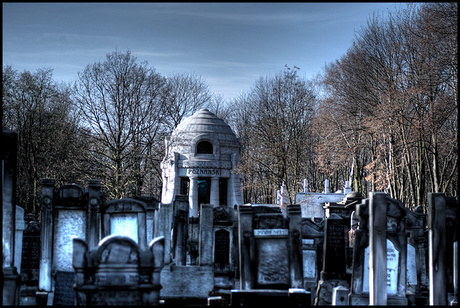The New Cemetery
The cemetery on ul. Bracka and ul. Zmienna, the largest Jewish cemetery in Europe, was created in 1892 when residents of the nearby neighborhood refused to allow the expansion of the old cemetery on ul. Wesola, containing over 3,000 graves. Izrael Poznanski donated the first 10.5 hectares of land towards the establishment of a new cemetery. The outbreak of a cholera epidemic in 1892 forced the Russian authorities to give the final go ahead to establish the new cemetery. Thus, the first people buried there in the winter of 1892 were approximately 700 cholera victims. In 1893, 1,139 people were buried at the new cemetery. From 1893 to 1896, the basic construction of the cemetery was completed under the supervision of well-known architect Adolf Zeligson.
The Beit Tahara (Funeral Home) was founded by Mina Dobrzynska Konsztat in 1896 and completed in 1898. In 1900, the cemetery was greatly expanded by a purchase of land from Albert Cukier and in 1913 other lands were added. In that year, houses for cemetery workers and a wooden synagogue were built. The cemetery was severely damaged during WWI and many buildings destroyed. Its renovation was supported financially by factory owners. By 1925, the original wooden fence surrounding the cemetery was replaced by the red brick wall that still stands today. All tombstones in the cemetery face east. In the 19th century, many were colorfully painted, traces of which can still be seen.
After the German occupation in 1939, the cemetery became part of the eastern section of the enclosed Lodz ghetto. A total of about 200,000 Jews were incarcerated in the ghetto. Between 1940 and 1944, approximately 43,000 burials took place in the spare part of the cemetery that became known as the Pole Gettowe or Ghetto Field. Many of those interred were victims of starvation, cold and disease (especially typhus); they included Jews from Germany, Austria, Czechoslovakia and Luxembourg, who were transported to the ghetto in 1941, as well as Roma (Gypsies) who died in the Gypsy Camp in the ghetto. The cemetery was the site of mass executions of Jews, Roma and non-Jewish Poles: the graves of the Polish scouts and soldiers of the Home Army are found there. The Germans forbade the use of stone grave markers, so burial sites were marked with metal bed frames or low cement posts. After the ghetto was liquidated in August 1944, about 830 Jews were left as a clean-up crew. They were forced to dig large holes for their own graves near the cemetery wall. The Nazis did not have enough time to kill them, and the empty holes have been left as a remembrance.
Right after WWII, Lodz became one of the largest gathering places of Jewish survivors of concentration camps and refugees from the U.S.S.R. This is the reason why so many graves from the first post-war years can be found there. A symbolic grave was constructed for 84 Jewish women from Lodz, from the Stutthof concentration camp, who were murdered by the Nazis in 1945 near Wejherowo. In 1956, a monument in memory of the victims of the Lodz ghetto by Muszko was erected at the cemetery. It features a smooth obelisk, a menorah (an important symbol of the Jewish nation), and a broken oak tree with leaves stemming from the tree (symbolizing death, especially death at a young age). Also in 1956, the city authorities widened a road that reduced the southwest area of the cemetery. Tombstones were moved and remain in locations other than the original ones. The cemetery deteriorated and was vandalized over the following decades.
The first attempts to protect the cemetery were made in the mid-1970s. In 1980, the cemetery was registered as an historical site. In 1995, the city of Lodz and the Organization of Former Residents of Lodz in Israel established the Monumentum Iudaicum Lodzense Foundation to preserve the cemetery and other remains of Jewish culture in Lodz. In 1996, the World Restitution Organization joined the foundation. In recent years, a project was begun to place low concrete markers on the grave sites in the Ghetto Field. The Ghetto Field is marked by two large Ohels -- a brick construction marking the graves of rabbis, tzaddiks and spiritual masters of Chassidism -- covering the final resting place of the rabbinical dynasty of Pabianice (see section "G-V" in the cemetery plan) and the tzaddikim dynasty from Sochaczew (see section "G-IV" in the cemetery plan). Overgrown vegetation and moisture threaten the condition of the tombstones and create a significant problem in negotiating one's way through the cemetery. Recent efforts have focused on clearing vegetation and leveling the ground, as well as restoration of specific tombstones and mausoleums, the funeral home and the wall surrounding the cemetery.



